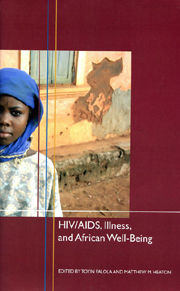Book contents
- Frontmatter
- Contents
- Acknowledgments
- Part I Context
- Part II Illness Case Studies
- Part III Globalization, Development, and Health
- Part IV HIV/AIDS
- 12 Of Savages and Mass Killing: HIV/AIDS, Africa and the Crisis of Global Health Governance
- 13 Vicissitudes of AIDS Policies in Burkina Faso from 1985 to 2001: A Historical Perspective
- 14 Factors Associated with Deliberate Attempts to Transmit HIV Infection among Persons Living with HIV/AIDS in Tanzania
- 15 Development and Alternative Mitigation Treatment Opportunities of the HIV/AIDS Epidemic
- 16 Confusion, Anger, and Denial: Results of HIV/AIDS Focus Group Discussions with Urban Adult Zimbabweans
- 17 Three Proposals for Analyzing the Economic Growth Effects of HIV/AIDS in Sub-Saharan Africa
- List of Contributors
- Index
- Rochester Studies in African History and the Diaspora
13 - Vicissitudes of AIDS Policies in Burkina Faso from 1985 to 2001: A Historical Perspective
from Part IV - HIV/AIDS
Published online by Cambridge University Press: 05 February 2013
- Frontmatter
- Contents
- Acknowledgments
- Part I Context
- Part II Illness Case Studies
- Part III Globalization, Development, and Health
- Part IV HIV/AIDS
- 12 Of Savages and Mass Killing: HIV/AIDS, Africa and the Crisis of Global Health Governance
- 13 Vicissitudes of AIDS Policies in Burkina Faso from 1985 to 2001: A Historical Perspective
- 14 Factors Associated with Deliberate Attempts to Transmit HIV Infection among Persons Living with HIV/AIDS in Tanzania
- 15 Development and Alternative Mitigation Treatment Opportunities of the HIV/AIDS Epidemic
- 16 Confusion, Anger, and Denial: Results of HIV/AIDS Focus Group Discussions with Urban Adult Zimbabweans
- 17 Three Proposals for Analyzing the Economic Growth Effects of HIV/AIDS in Sub-Saharan Africa
- List of Contributors
- Index
- Rochester Studies in African History and the Diaspora
Summary
In sub-Saharan Africa, Burkina Faso (in West Africa) is within a group of countries with low HIV prevalence, but where HIV/AIDS is nonetheless considered a major problem. According to Guiard-Schmid, the first clinical case of AIDS in Burkina Faso was diagnosed at the National Hospital Yalgado Ouédraogo in Ouagadougou in 1985. Sera of patients from this center were tested in Paris, and some were declared HIV-1 positive. Serological research in 1986 attested to the presence of HIV 1 and HIV 2. Other documents on the first case of HIV/AIDS in Burkina Faso indicate that the HIV/AIDS epidemic broke out in the mid-1980s. The data of the AIDS commission of Burkina Faso show the first six AIDS cases in 1986 (table 13.1).
A closer look at the reports on new cases of AIDS reveals a global increase of declared cases between 1986 and 1997 (table 13.1). The general HIV/AIDS prevalence amounted to 3.4 percent of the population in 1991. It increased to 7.17 percent in 1997 before decreasing to 6.5 percent in 2001 and to 2.7 percent in 2004 (table 13.1). Burkina Faso, however, is still plagued by the HIV/AIDS epidemic.
Yet, from 1986 to 1997, Burkina Faso developed several strategies in the fight against HIV/AIDS: the fight against prostitution, the short-term plan (1987–89), the midterm plan (1990–95), and the population plan and fight against HIV/AIDS (PPLS from 1996 to 1999).
- Type
- Chapter
- Information
- HIV/AIDS, Illness, and African Well-Being , pp. 287 - 308Publisher: Boydell & BrewerPrint publication year: 2007



